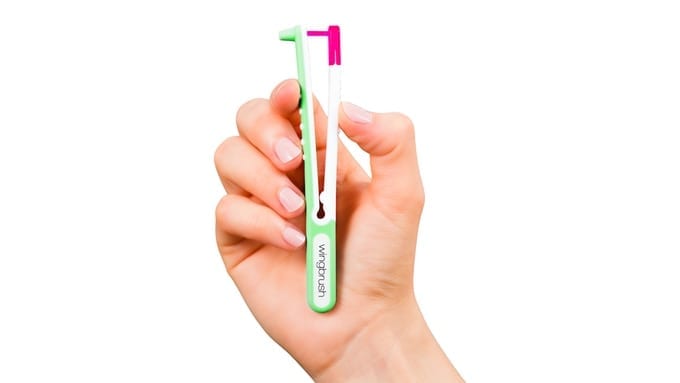Scientists from Cologne, Germany, bring you the brand new Wingbrush: the master of all interdental toothbrushes out there. Just how many times have you hurt yourself over the bathroom mirror while flossing? The wingbrush is here, to solve that very problem. We know you were waiting for a full product review after reading the teaser here.
The kickstarter project reached 12412 backers and a whopping 331475 euros, of the 5000 goal. The all new Wingbrush guarantees efficient cleaning of places where normal toothbrushes and floss fail to reach. The product is dainty and fits snugly in the hand but at the same time, like the Taylor Swift song, it’s delicate. The bottle-cleaner like bristles on the end are easily bendable, which on the flip side, feel breakable. When I used it, I was constantly in the fear that I might just break it.

Wingbrush is not a conventional brush, so don’t expect it to clean the plaque on your teeth, because it is not meant to. The intuitive feeler will help you detect the interdental spaces, but one must be careful while cleaning those spaces because it is very much possible that you will bleed your gums, because I did.
Never the less, the results were more than satisfying. The wingbrush reaches places a normal floss, or toothbrush can’t. This really works in the favour of the product, because it takes dental hygiene to a whole new level.
Fun fact: Did you know, the only time you truly clean your skeleton, is when you brush your teeth? So, we might as well do it properly, right? Research has shown that a common cause for periodontitis is lack of efficiency in cleaning of interdental spaces. Wingbrush was designed keeping this as the end goal- Easier flossing.
 The wingbrush comes in three sizes, so you must choose wisely. Ignorance in doing so might lead to gum bleeding, discomfort there after, and inefficient cleaning.
The wingbrush comes in three sizes, so you must choose wisely. Ignorance in doing so might lead to gum bleeding, discomfort there after, and inefficient cleaning.
- ISO 0 (small): Fits in every gap, especially for small interdental spaces, patients with brackets or retainers.
- ISO 2 (medium): For wider gaps or teeth with crowns, bridges or implants.
- ISO 3 (large): Conically shaped bristles, serves a wide range with a small wire. Perfect size for patients with periodontitis or wide gaps.
If you have braces, this is the kind of brush you’re looking for. I’ve had braces, and I know how much I’d wished for a cleaning device which would keep my teeth spic and span, without getting stuck in the wires. Once you get used to the wingbrush, you can exploit it fully. However, it is not limited to braces. If you’ve had a root canal, an implant or a dental surgery that prevents you from using normal brushes, but allows you to have a flashy golden tooth – the wingbrush has got you covered.
 The product still has a lot of room for improvement. For starters, the wing can be a little rigid and not easily bendable. The one good thing that they did was including different sizes for different types of gaps, but here’s the catch, for a person like me, who has different gaps all over, it gets a little tedious to keep changing wings while brushing. Even the smallest size of the wire brush couldn’t clean some of my tightly spaced teeth.
The product still has a lot of room for improvement. For starters, the wing can be a little rigid and not easily bendable. The one good thing that they did was including different sizes for different types of gaps, but here’s the catch, for a person like me, who has different gaps all over, it gets a little tedious to keep changing wings while brushing. Even the smallest size of the wire brush couldn’t clean some of my tightly spaced teeth.
The product claims cleaning of teeth in less than a minute. I have been using it for three days now, and it still takes me at least five minutes to clean all the spaces. Also, cleaning of the wire brush itself, feels like a hassle. The plaque sticks on to the wire brush, and it must be cleaned before using it for other gap.
 Piksters, another interdental brush company uses the same concept, but it comes without the patented, intuitive “feeler” which helps you detect the gaps. The “feeler” concept works beautifully in the case of Wingbrush
Piksters, another interdental brush company uses the same concept, but it comes without the patented, intuitive “feeler” which helps you detect the gaps. The “feeler” concept works beautifully in the case of Wingbrush
Read more about the same on the official kickstarter page of the company here.
If you’re interested, you can buy the wingbrush here.


